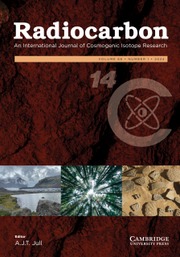Crossref Citations
This article has been cited by the following publications. This list is generated based on data provided by
Crossref.
Leary, Jim
Canti, Matthew
Field, David
Fowler, Peter
Marshall, Peter
and
Campbell, Gill
2013.
The Marlborough Mound, Wiltshire. A Further Neolithic Monumental Mound by the River Kennet.
Proceedings of the Prehistoric Society,
Vol. 79,
Issue. ,
p.
137.
Sironić, Andreja
Krajcar Bronić, Ines
Horvatinčić, Nada
Barešić, Jadranka
Obelić, Bogomil
and
Felja, Igor
2013.
Status report on the Zagreb Radiocarbon Laboratory – AMS and LSC results of VIRI intercomparison samples.
Nuclear Instruments and Methods in Physics Research Section B: Beam Interactions with Materials and Atoms,
Vol. 294,
Issue. ,
p.
185.
Baydoun, Rana
Samad, Omar
Aoun, Maria
Nsouli, Bilal
and
Younes, Ghassan
2014.
Set-up, optimization and first set of samples at the radiocarbon laboratory in Lebanon.
Geochronometria,
Vol. 41,
Issue. 1,
p.
87.
Raghavan, Maanasa
DeGiorgio, Michael
Albrechtsen, Anders
Moltke, Ida
Skoglund, Pontus
Korneliussen, Thorfinn S.
Grønnow, Bjarne
Appelt, Martin
Gulløv, Hans Christian
Friesen, T. Max
Fitzhugh, William
Malmström, Helena
Rasmussen, Simon
Olsen, Jesper
Melchior, Linea
Fuller, Benjamin T.
Fahrni, Simon M.
Stafford, Thomas
Grimes, Vaughan
Renouf, M. A. Priscilla
Cybulski, Jerome
Lynnerup, Niels
Lahr, Marta Mirazon
Britton, Kate
Knecht, Rick
Arneborg, Jette
Metspalu, Mait
Cornejo, Omar E.
Malaspinas, Anna-Sapfo
Wang, Yong
Rasmussen, Morten
Raghavan, Vibha
Hansen, Thomas V. O.
Khusnutdinova, Elza
Pierre, Tracey
Dneprovsky, Kirill
Andreasen, Claus
Lange, Hans
Hayes, M. Geoffrey
Coltrain, Joan
Spitsyn, Victor A.
Götherström, Anders
Orlando, Ludovic
Kivisild, Toomas
Villems, Richard
Crawford, Michael H.
Nielsen, Finn C.
Dissing, Jørgen
Heinemeier, Jan
Meldgaard, Morten
Bustamante, Carlos
O’Rourke, Dennis H.
Jakobsson, Mattias
Gilbert, M. Thomas P.
Nielsen, Rasmus
and
Willerslev, Eske
2014.
The genetic prehistory of the New World Arctic.
Science,
Vol. 345,
Issue. 6200,
Ducasse, Sylvain
Pétillon, Jean-Marc
and
Renard, Caroline
2014.
Le cadre radiométrique de la séquence solutréo-badegoulienne du Cuzoul de Vers (Lot, France) : lecture critique et compléments.
Paléo,
p.
37.
Törnqvist, Torbjörn E.
Rosenheim, Brad E.
Hu, Ping
and
Fernandez, Alvaro B.
2015.
Handbook of Sea‐Level Research.
p.
347.
Wood, Rachel
2015.
From revolution to convention: the past, present and future of radiocarbon dating.
Journal of Archaeological Science,
Vol. 56,
Issue. ,
p.
61.
Santos Arévalo, Francisco-Javier
Gómez Martínez, Isabel
and
Agulló García, Lidia
2015.
14C SIRI samples at CNA: Measurements at 200 kV and 1000 kV.
Nuclear Instruments and Methods in Physics Research Section B: Beam Interactions with Materials and Atoms,
Vol. 361,
Issue. ,
p.
322.
Jull, A.J.Timothy
Scott, E.Marian
and
Bierman, Paul
2015.
The CRONUS-Earth inter-comparison for cosmogenic isotope analysis.
Quaternary Geochronology,
Vol. 26,
Issue. ,
p.
3.
Blockley, Simon P.E.
Edwards, Kevin J.
Schofield, J. Edward
Pyne-O'Donnell, Sean D.F.
Jensen, Britta J.L.
Matthews, Ian P.
Cook, Gordon T.
Wallace, Kristi L.
and
Froese, Duane
2015.
First evidence of cryptotephra in palaeoenvironmental records associated with Norse occupation sites in Greenland.
Quaternary Geochronology,
Vol. 27,
Issue. ,
p.
145.
Murray, Andrew
Buylaert, Jan-Pieter
and
Thiel, Christine
2015.
A luminescence dating intercomparison based on a Danish beach-ridge sand.
Radiation Measurements,
Vol. 81,
Issue. ,
p.
32.
Lee, Youngseon
Lee, Jaeyong
and
Kim, Jangsuk
2015.
Bayesian Analysis for Uncertainty of Radiocarbon Dating.
Korean Journal of Applied Statistics,
Vol. 28,
Issue. 3,
p.
371.
Trumbore, S. E.
Xu, X.
Santos, G. M.
Czimczik, C. I.
Beaupré, S. R.
Pack, M. A.
Hopkins, F. M.
Stills, A.
Lupascu, M.
and
Ziolkowski, L.
2016.
Radiocarbon and Climate Change.
p.
279.
Xu, Sheng
Cook, Gordon T.
Cresswell, Alan J.
Dunbar, Elaine
Freeman, Stewart P.H.T.
Hastie, Helen
Hou, Xiaolin
Jacobsson, Piotr
Naysmith, Philip
Sanderson, David C.W.
Tripney, Brian G.
and
Yamaguchi, Katsuhiko
2016.
14C levels in the vicinity of the Fukushima Dai-ichi Nuclear Power Plant prior to the 2011 accident.
Journal of Environmental Radioactivity,
Vol. 157,
Issue. ,
p.
90.
Xu, Sheng
Cook, Gordon T.
Cresswell, Alan J.
Dunbar, Elaine
Freeman, Stewart P. H. T.
Hou, Xiaolin
Jacobsson, Piotr
Kinch, Helen R.
Naysmith, Philip
Sanderson, David C. W.
and
Tripney, Brian G.
2016.
Radiocarbon Releases from the 2011 Fukushima Nuclear Accident.
Scientific Reports,
Vol. 6,
Issue. 1,
Kim, Jangsuk
Wright, David K
Lee, Youngseon
Lee, Jaeyong
Choi, Seonho
Kim, Junkyu
Ahn, Sung-Mo
Choi, Jongtaik
Seong, Chuntaek
Hyun, Chang Ho
Hwang, Jaehoon
Yang, Hyemin
and
Yang, Jiwon
2016.
AMS Dates from Two Archaeological Sites of Korea: Blind Tests.
Radiocarbon,
Vol. 58,
Issue. 1,
p.
115.
Sykes, Naomi
Ayton, Gema
Bowen, Frazer
Baker, Karis
Baker, Polydora
Carden, Ruth F.
Dicken, Craig
Evans, Jane
Hoelzel, A. Rus
Higham, Thomas F.G.
Jones, Richard
Lamb, Angela
Liddiard, Robert
Madgwick, Richard
Miller, Holly
Rainsford, Clare
Sawyer, Peta
Thomas, Richard
Ward, Christopher
and
Worley, Fay
2016.
Wild to domestic and back again: the dynamics of fallow deer management in medieval England (c. 11th-16thcentury AD).
STAR: Science & Technology of Archaeological Research,
Vol. 2,
Issue. 1,
p.
113.
Phillips, Fred M.
Argento, David C.
Bourlès, Didier L.
Caffee, Marc W.
Dunai, Tibor J.
Goehring, Brent
Gosse, John C.
Hudson, Adam M.
Jull, A.J. Timothy
Kelly, Meredith
Lifton, Nathaniel
Marrero, Shasta M.
Nishiizumi, Kuni
Reedy, Robert C.
and
Stone, John O.H.
2016.
Where now? Reflections on future directions for cosmogenic nuclide research from the CRONUS Projects.
Quaternary Geochronology,
Vol. 31,
Issue. ,
p.
155.
Wang, Shing-Lin
Burr, George S.
Wang, Pei-Ling
Lin, Li-Hung
and
Nguyen, Vicki
2016.
Tracing the sources of carbon in clay minerals: An example from western Taiwan.
Quaternary Geochronology,
Vol. 34,
Issue. ,
p.
24.
Steinhof, Axel
2016.
Radiocarbon and Climate Change.
p.
253.




